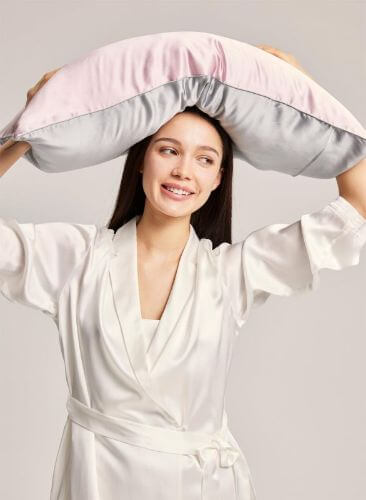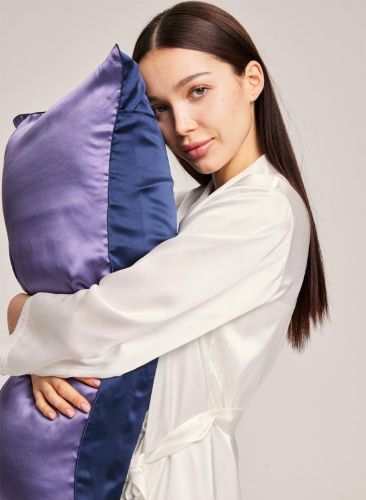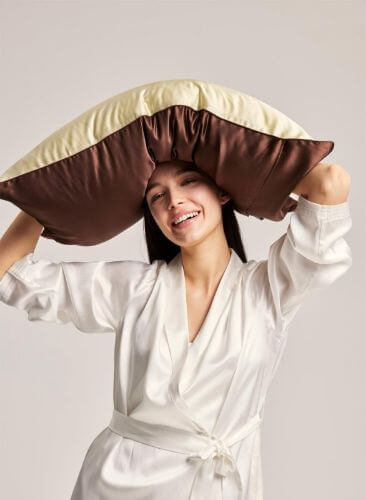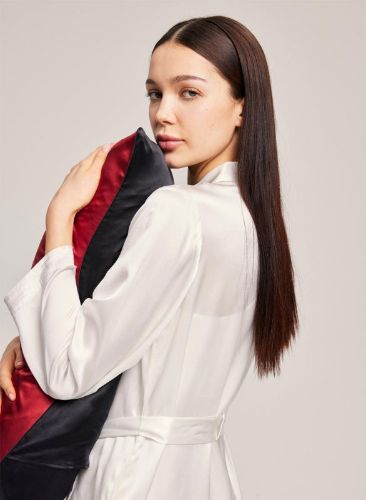A lot of people ask about whether or not silk pillowcases are good for your skin and hair.
So here I’m going to be talking about some of the claims you might have heard about silk and whether or not they make sense.
Let’s start with hair because that’s where I see the biggest difference.

Check Out This Great Silk Pillowcase!
Table of Contents
No Studies
First up I’m going to tell you straight there are no published peer-reviewed direct clinical trials on using silk for improving your skin or hair. It’s really annoying but this is the case with a lot of beauty stuff.
Research is expensive and a lot of peer-reviewed research is funded by the government. It’s really hard for the government to justify spending money to help you get smoother hair or nicer skin when it could be spending this money on cancer research, for example.
Mechanical Hair Damage
But we do know that silk is really slippery. It has a lower coefficient of friction than a lot of other pillowcase materials, like linen and cotton.
We know that mechanical wear and tear is one of the main causes of hair damage. This includes combing, brushing, hair ties and even hair strands sliding past each other.
Given that we sleep for about a third of our lives and we’re smooshing our hair into the pillowcase, it makes sense that there’s a lot of damage happening there and using a less frictiony pillowcase might help.
Best Bed Sheets For Acne-prone Skin
Less Absorbent
Silk also doesn’t absorb as much water as cotton or linen and so if your hair is quite porous and prone to losing moisture then using a less absorbent pillow case might also help keep it more moisturized.

100% Pure Mulberry Silk Pillowcase!
My Experience
I first started using a silk pillowcase before I dyed my hair and I didn’t see much of a difference. I think the reason for that is because, as my hairdresser put it, my hair is very strong.
But after double bleaching it, my hair got really fragile and porous. It started drying out really easily and I saw a massive difference when I slept on a silk pillowcase versus my usual cotton ones.
When I woke up after sleeping on the silk one, it felt like my hair was normal. But on the cotton one, it felt like all the conditioner had worn off my hair. It was catching on itself and it felt crunchy, dried out, duller and frizzy.
The biggest difference is when I’m lazy and I don’t dry out my hair properly before I go to sleep.
This is really bad because when your hair’s wet, the cuticle stands up and these are like scales and so they stick up more. They’re more likely to bash into each other and cause lots of damage so don’t do this.
But with cotton, when I go to sleep with wet or even slightly damp hair, when I wake up, it’s really knotted and crunchy. But with silk it’s a lot more manageable.
One of the big worries I had about silk was with washing, but it turns out it’s actually not that hard to look after it.
Ideally you’d hand wash them or dry clean them, but I’ve actually been washing them in my regular laundry. I turned them inside out, put them in a delicates bag and then put them on a delicate spin cycle at a low temperature with liquid detergent.
My older silk pillowcase is about three years old and is still going strong.
I also hang them on the line away from direct sun.
Apart from pillowcases, there are a few other options for keeping your hair nice with silk.
If you have long hair, a lot of your hair might hang off the pillow and it’s usually the ends that are the most damaged and most prone to getting more damage.
If you don’t tie up your hair, then your hair can get caught between your body and the sheets and get really smushed there.
You can use silk sheets but they are pretty expensive. Much more budget-friendly option is to use the silk bonnet. You can gather up your hair and put it inside and so it keeps it all together and safe.
Silk and Skin
With silk and skin it’s a similar story.
Silk has less friction and it doesn’t absorb as much water and so it can help with some skin issues.
You might have heard that silk pillowcases can prevent wrinkles because of the low friction. It means that your skin gets tugged less.
I’m not super convinced by this reasoning. There are things called sleep wrinkles, but these are mostly caused by your sleeping position.
If you sleep on your side or your stomach, then your face gets smushed and creased and over time this repeated creasing can lead to an etched in wrinkle.
These sleep lines are vertical and they don’t quite match with your muscle movements which is where most of your wrinkles come from.
But sleep wrinkles mostly come from the weight of your head which is pretty darn heavy.
Compared to the weight of your head, the impact of the friction from your pillowcase is really tiny.
If you’re worried about sleep lines, I recommend switching to sleeping on your back rather than changing the material of your pillowcase.
Changing your sleep position can be difficult and it can impact other areas of your health.
So it might not be worth it, depending on your individual situation.
But if you are interested, there are special pillows designed for helping you sleep on your back.
But one skin benefit I have found with using a silk pillowcase is that I get less awkward creases on my skin when I wake up.
You know how sometimes your pillow imprints itself on your skin and you’ve got a crease and you try to put makeup over it and it’s a bit awkward and it takes a little while to fade.
I noticed that I got a lot less of these when I started using silk pillowcases.

Smooth, Lustrous and Soothing Silk Pillowcase!
Silk and Skincare Products
Another good thing about silk is that it doesn’t absorb as much moisture as something like cotton.
So when I’m using a silk pillowcase I find that I wake up with my skin a lot more hydrated and plump and smooth.
It also doesn’t soak up as much of your products as cotton and so your skincare products go less to waste.
Theoretically that means it’s feeding bacteria a bit less and so your pillowcase will get gross slower. You should be washing your pillowcases regularly to prevent breakouts.
Silk and Amino Acids
You might have heard some people say that silk has amino acids, which can absorb through your skin and feed it.
This is a myth.
Silk does have amino acids but they’re bound up into protein chains that are too big to go through your skin.
This is a good thing because it means it stays in the pillowcase and so your pillowcase doesn’t slowly get absorbed into your skin. At the end of the day you still have a pillowcase.
Silk and Maskne
Another good use of silk that I found is with face masks.
I don’t know about the rest of you, but I’ve been having massive issues with maskne.
This is breakouts that come on your face because you’ve been wearing a face mask.
I’ve been getting really irritated red spots in places where I usually don’t get breakouts and my chin has been a bit of a disaster.
The main reasons that you get these breakouts is because the mask is rubbing against your skin and that makes it really irritated.
You also have a ton of moisture trapped under there from your breath and from your sweat and this is the perfect storm for your skin barrier to get compromised.
And so it gets more irritated, it gets more leaky and so that means breakouts.
Silk is one of your best bets for dealing with the friction because it’s so slippery.
A silk face mask cam significantly cut down a lot of that irritation and friction.
If your body skin is quite sensitive and easily irritated, then you might find that wearing silk clothing helps as well because it’s so slippery.

Your Skin and Hair Will Love This Silk Pillowcase!
Drawbacks of Silk
So those are the benefits of silk there are some drawbacks as well.
Firstly silk isn’t vegan. It’s produced by silkworms and the silkworms are killed during the production process. So if you’re vegan you probably want to avoid silk.
Silk is also one of the more expensive fabrics. Other fabrics are usually going to be cheaper.
There are some satin fabrics that have similar benefits to silk.
The satin refers to how the fabrics are woven together so that they’re smoother and less frictiony and more silk-like.
But they tend to have other drawbacks.
For a long time I was quite hesitant about using silk pillowcases because one of my friends in high school used to have satin pillowcases.
And every time I slept over, my hair would go really flat and staticky and my head would get really hot and sweaty.
Later on I realized that this was because they were polyester satin.
I haven’t had any of these issues with the silk pillowcases I’ve tried.
If you do want to try a satin fabric, I’d recommend sateen. This is cotton based, so it shouldn’t have these heat or static problems, but it will still absorb more moisture than silk.
Another disadvantage of silk is that you do need to iron it, which is more important for clothing than for pillowcases.
But it does also feel really smooth and it’s really hard to stop touching myself!